Swedish Navy
The Royal Swedish Navy (Swedish: Svenska marinen) is the naval branch of the Swedish Armed Forces.[1] It is composed of surface and submarine naval units – the Royal Fleet (Kungliga Flottan) – as well as marine units, the Amphibious Corps (Amfibiekåren).
In Swedish, vessels of the Swedish Royal Navy are given the prefix "HMS", short for Hans/Hennes majestäts skepp (His/Her Majesty's Ship). In English, this is sometimes changed to "HSwMS" ("His Swedish Majesty's Ship") to differentiate Swedish vessels from those of the British Royal Navy.[2]
History
Early Swedish kings (c. 9th–14th centuries) organised a Swedish Royal Navy along the coastline through ledungen. This involved combined rowing and sailing ships (without artillery). This system became obsolete with the development of society and changes in military technology. No later than in the 14th century, the duty to serve in ledungen was replaced by a tax. In 1427, when Sweden was still part of the Kalmar Union (with Denmark and Norway), Swedish warships did however participate in the naval battle of Öresund against the Hanseatic League. It is unclear how this force was organised and exactly on what basis.
On 7 June 1522, one year after the separation of Sweden from the Kalmar Union, Gustav Vasa purchased a number of ships from the Hanseatic town of Lübeck. Official Swedish histories since the 19th century have often recorded this day as the birth of the current Swedish Royal Navy. The museum ship Vasa in Stockholm was a 17th-century ship of the Royal Swedish Navy (Kungliga flottan).
The Amphibious Corps dates back to 1 January 1902, when a separate "Coastal Artillery" (Kustartilleriet) was established, and Marinen came into use as the name of the service as a whole. The last decade of the 20th century saw the abandonment of the coastal fortifications and the force became a more regular marine corps, renamed Amphibious Corps (Amphibious Corps) in 2000.
For most of the twentieth century the Swedish Royal Navy focused on the threat of a full-scale invasion of Sweden via the Baltic and on protecting commercial shipping. Sweden's location on the Scandinavian peninsula makes it highly dependent of maritime trade: 90% imports and exports enter or leave Sweden through the Baltic. In 1972 the government decreed that non-military measures should be used to protect merchant shipping. The resolution led to the de-commissioning of all the navy's destroyers and frigates, though the non-military measures the government intended to use to protect shipping have never been specified.
The navy first participated in a UN-led peacekeeping mission in October 2006 when the corvette HSwMS Gävle began performing coastal surveillance duties for the United Nations Mission in Lebanon. HSwMS Gävle was relieved by HSwMS Sundsvall, which returned to Sweden in September 2007.
HSwMS Malmö, HSwMS Stockholm, and HSwMS Trossö took part in the EU-led EUNAVFOR operation (2008- ) off the coast of the Horn of Africa. In 2010, HSwMS Carlskrona was the EUNAVFOR flagship, housing the fleet headquarters led by RAdm (LH) Jan Thörnqvist.[3]
Organization
Until recently, the Navy was led by the Chief of the Navy (Chefen för marinen, CM), who was typically a Vice Admiral. This office has been eliminated, and the highest officer of the Navy is now the Chief of Navy (Marinchefen), Rear Admiral Ewa Skoog Haslum, who is the senior representative of the Swedish Royal Navy's combat forces.
The Marine units use the same system of rank as the Army.
Naval units
- 1st Submarine Flotilla (1. ubflj) located at Karlskrona
- 3rd Naval Warfare Flotilla (3. sjöstridsflj) located at Karlskrona
- 4th Naval Warfare Flotilla (4. sjöstridsflj) located at Berga at the Muskö naval base.
Amphibious units
- 1st Marine Regiment (Amf 1) located in Berga
Bases
- Muskö naval base, located at Muskö island in the Stockholm archipelago. The base serves as the headquarters of the Swedish Royal Navy since September 2019.
- Karlskrona naval base (MarinB), located at Karlskrona with detachments at Berga, Gothenburg and Skredsvik.
Training units
- Swedish Naval Warfare Centre (SSS) located in Karlskrona
Equipment
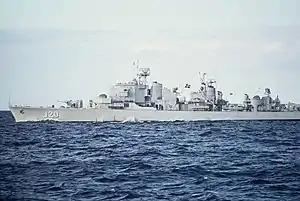
In the decades following World War II, the Swedish Royal Navy was organised around three light cruiser groups (Tre Kronor, Göta Lejon and Gotland). In the early 1960s, a decision, known as Navy Plan 60 (Swedish: Marinplan 60), was made to scrap the cruisers and move towards a larger fleet of smaller vessels. The last cruiser, Göta Lejon, was sold in 1970 to Chile, where she was renamed Almirante Latorre. The fleet at the time comprised some 24 destroyers and frigates for surface warfare (mainly in the Baltic Sea) and anti-submarine warfare.
The Swedish Royal Navy started to experiment with missiles, based on a recovered German V-2 rocket, as early as 1944. The main armament of the fleet was artillery and torpedoes for surface warfare and anti-submarine rockets for anti-submarine warfare. Helicopters (Alouette, Boeing Vertol) were introduced in the late 1950s and 1960s and this fleet air arm remained an integral part of the fleet and its operations until an independent helicopter arm was created in the 1990s.
The 1972 decision made by the Government to decommission all destroyers and frigates within the next decade limited the Navy's endurance considerably, but the use of smaller short-range ships was at the time deemed adequate for anti-shipping missions along the coast and in the archipelago. In the 1980s, this assessment was proven wrong by repeated failures in anti-submarine warfare operations with inadequate ships and equipment. Today, the largest (surface) combat ships are corvettes which combine surface warfare, anti-submarine warfare and mine clearance functions with a better endurance and seaworthiness than the budget fleet from the 1980s.
Since the 1980s, Swedish surface warships have been named after Swedish cities, while submarines are named after Swedish provinces and minehunters after Swedish lighthouses. The surface ships are mostly small, relying on agility and flexibility. Examples of these are the Stockholm and Göteborg-class corvettes. The Navy is currently taking into service the new, larger, Visby class of stealth corvettes. A new submarine class, Gotland, similar to the older Västergötland, was commissioned in 1998. Its air-independent Stirling engine enables submerged endurance never before seen in conventional submarines. Gotland has been on lease with crew and all to the US Navy and was based in San Diego.
The Amphibious Battalion is built around the Stridsbåt 90H, a small combat boat capable of carrying 21 troops for fast transports and landings in the archipelago. It is also equipped with larger transport boats, but relies on the Army, Navy and Air Force for heavy transports and protection. Cooperation with the Royal Netherlands Navy is under investigation for Amphibious Warfare.
The Swedish Armed Forces (Swedish: Försvarsmakten) operate three types of helicopters: NHIndustries NH90 (HKP14) (18 in service), AgustaWestland AW109 (HKP15) (20 in service) and Sikorsky UH-60 Black Hawk (HKP16) (15 in service). Eight of the AgustaWestland AW109 helicopters have been modified to be operational from the Visby-class corvettes and HSwMS Carlskrona. Nine of the NHIndustries NH90 helicopters are equipped with sonars and radars for anti-submarine warfare.
Upcoming investments
The next generation of submarines, the A26 class, was ordered from Saab Technologies in 2015 and will join the navy starting 2022. The two units will replace the submarines of Södermanland class. In parallel, the Gotland class will undergo a mid-life upgrade.
In 2017 a new intelligence ship to replace HSwMS Orion was ordered from Saab Technologies. The new ship is to be commissioned by 2020 and have a displacement of 2,300 tons.
An additional 18 units of the Swedish version of the CB90-class fast assault craft named Stridsbåt 90HSM, where "M" stands for "modernized", wlll be delivered to the Amphibious Corps during the end of 2018. Like previous versions, the units will be built at Dockstavarvet.
Submarines
| Class | Photo | Number of ships |
Builder | Origin | Notes |
|---|---|---|---|---|---|
| Gotland class |  | 3 | Kockums AB | 2 out of 3 units have undergone a mid-life upgrade | |
| Södermanland class |  | 2 | Kockums AB | These will be replaced in 2022 by two new units of A26-class |
Corvettes
| Class | Photo | Number of ships |
Builder | Origin | Notes |
|---|---|---|---|---|---|
| Göteborg class | 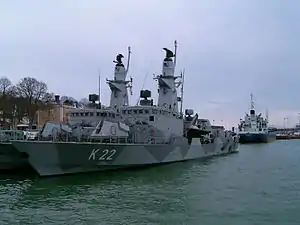 | 2 | Karlskronavarvet AB | Total of 4 ships completed. 2 in service and 2 decommissioned. | |
| Visby class |  | 5 | Karlskronavarvet AB | ||
Minesweepers
| Class | Photo | Number of ships |
Builder | Origin | Notes |
|---|---|---|---|---|---|
| Koster class | .jpg.webp) | 5 | Karlskronavarvet AB | Total of 7 ships completed. 5 in service and 2 decommissioned. | |
| Styrsö class | 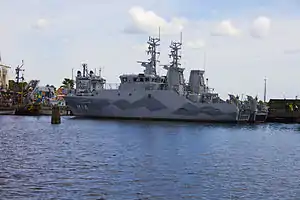 | 4 | Karlskronavarvet AB | 2 ships converted to diving support vessels and 2 ships to command and support vessels | |
Patrol boats
| Class | Photo | Number of ships |
Builder | Origin | Notes |
|---|---|---|---|---|---|
| Stockholm class |  | 2 | Karlskronavarvet AB | Downgraded from corvettes[4] | |
| Tapper class | 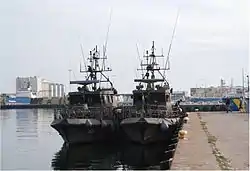 | 11 | Djupviks varv | Total of 12 ships completed. 11 in service and 1 decommissioned. |
Combat boats
| Class | Photo | Number of ships |
Builder | Origin | Notes |
|---|---|---|---|---|---|
| Stridsbåt 90 | 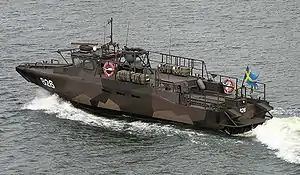 | 147 | Dockstavarvet, Gotlandsvarvet | 18 additional units on order |
Ocean patrol vessels
| Class | Photo | Number of ships |
Builder | Origin | Notes |
|---|---|---|---|---|---|
| HSwMS Carlskrona |  | 1 | Karlskronavarvet, Karlskrona | Former mine layer M04 |
Signal intelligence vessels
| Class | Photo | Number of ships |
Builder | Origin | Notes |
|---|---|---|---|---|---|
| HSwMS Orion | .jpg.webp) | 1 | Karlskronavarvet, Karlskrona | Will be replaced in 2020 |
Auxiliary vessels, major
| Class | Photo | Number of ships |
Builder | Origin | Notes |
|---|---|---|---|---|---|
| HSwMS Trossö |  | 1 | OY Laivateollisuus | Command and support ship | |
| HSwMS Belos | 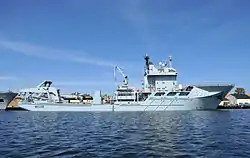 | 1 | Shipyard De Hoop | Submarine salvage ship. Carries the submarine rescue system URF. | |
| HSwMS Furusund |  |
1 | Åsiverken | Sub water research vessel |
Auxiliary vessels, others
- Landing craft
- G class (appr. 100 in service)
- Tugs
- HSwMS Hector (A254) Damen ASD3010 Coastal Tug
- HSwMS Hercules (A255) Damen ASD3010 Coastal Tug
- Torpedo salvage vessels
- HSwMS Pelikanen (A247)
- Transport ships
- HSwMS Loke (A344)
- HSwMS Nåttarö (A608)
- 600-class Fast Supply Vessels (16 vessels in service)
- Hovercraft
- Griffon 2000TD Hovercraft (3 craft in service)
Training ships
- Schooners
- HSwMS Falken (S02)
- HSwMS Gladan (S01)
- Ships for navigation education
- HSwMS Altair (A501)
- HSwMS Antares (A502)
- HSwMS Arcturus (A503)
- HSwMS Argo (A504)
- HSwMS Astrea (A505)
Commanders
Chiefs of the Navy
- 1937–1939: Charles de Champs
- 1939–1945: Fabian Tamm
- 1945–1953: Helge Strömbäck
- 1953–1961: Stig H:son Ericson
- 1961–1970: Åke Lindemalm
- 1970–1978: Bengt Lundvall
- 1978–1984: Per Rudberg
- 1984–1990: Bengt Schuback
- 1990–1994: Dick Börjesson
Chiefs of Navy Staff
- 1995–1998: Peter Nordbeck
Inspectors General of the Navy
- 1998–2001: Torsten Lindh
- 2001–2003: Jörgen Ericsson
Inspectors of the Navy
- 2003–2005: Jörgen Ericsson
- 2005–2011: Anders Grenstad
- 2011–2013: Jan Thörnqvist
Chiefs of Navy
- 2014–2016: Jan Thörnqvist
- 2016–2020: Jens Nykvist
- 2020–present: Ewa Skoog Haslum
See also
| Wikimedia Commons has media related to Swedish Navy. |
References
- Swedish Armed Forces: The Swedish Navy, accessed September 2020
- Allied Command Operations. "A Day Aboard HSwMS Kullen". NATO. Archived from the original on 20 October 2014. Retrieved 19 October 2014.
- "90 000 ton humanitär hjälp säkrades under svensk ledning" (in Swedish). Swedish Armed Forces. Archived from the original on 27 August 2010.
- "Patrullfartyg Stockholm". Försvarsmakten. Försvarsmakte. Archived from the original on 11 July 2017. Retrieved 15 July 2017.
External links
- Official website (in English)
- Official website (in Swedish)
- Göran Frilund – The Swedish Navy 1788–1809
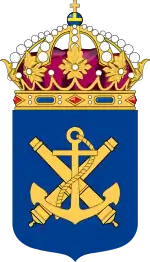
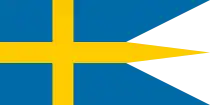
.svg.png.webp)
.svg.png.webp)